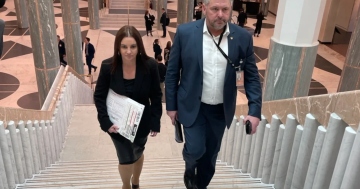
Secretary of the Department of Prime Minister and Cabinet Glyn Davis earns $400,000 more than the Prime Minister. Photo: University of Melbourne.
Prime Minister Anthony Albanese’s annual income is $607,516, but Glyn Davis, who heads the Department of Prime Minister and Cabinet, edges in on almost twice that amount at $1,011,410.
Treasurer Jim Chalmers gets $438,112, while Treasury Secretary Steven Kennedy rakes in more than double at $986,120.
The secretaries of the Attorney-General’s Department, the Department of Defence, and the Department of Social Services each earn $960,840, while the respective ministers they serve only get $403,063.50 a pop.
How can that be?
It’s a good question and one that crossbench Senator from Tasmania Jacqui Lambie has very publicly asked.
Senator Lambie has used social media to list the (publicly available) salaries of Federal Government ministers and the underlings heading up their respective departments.
Her motivation was no doubt to highlight how much all of them earn – the top pollies and the highest paid mandarins.
But she highlighted the stark comparisons in salaries between the highest levels of ministers and the highest levels of the public service.
“I’m just going to leave this here,” she posted on Instagram below an extensive list of salaries, which shows that even a number of public service commissioners, chairs and directors to be earning far more than the politicians.
“Millions struggle to make ends meet, yet taxpayer money lines the pockets of the privileged, where’s the fairness in that?
“Time to cap their salaries.”
While Senator Lambie earns a reasonable $233,660 a year, her constituents are among the lowest paid in Australia.
Which is probably why her post elicited quite a reaction, with numerous responses demanding to know how public servants can earn so much more than their political masters.
Professor Chris Wallace, from the University of Canberra’s School of Politics Economics & Society, penned an insightful explanation in the creative commons journal The Conversation.
She basically explains that the situation we find ourselves in today is a creation of politicians themselves, who have tried hard over decades (my words, not Professor Wallace’s) to compromise the senior public servants and the advice they give.
Professor Wallace’s whole article is well worth reading, but here’s the crux of it.
“The salaries of both politicians and public servants have long and specific histories,” she writes.
“Without an income, only the rich could afford to be politicians, so publicly paid allowances and salaries have historically been an important equity and inclusion measure. They remain so today.
“The original framers of the public service component of our Westminster system of government believed that to prevent conflicts of interest that drive corruption, the bureaucracy ought to be staffed by ‘permanent officers’ with job security.
“In exchange for what, barring wrongdoing, was going to be a lifetime career, public service pay was historically adequate but not extravagant.
“This nexus was broken when, in exchange for higher pay, the Keating government introduced five-year contracts for departmental secretaries in March 1994.
“Three departmental secretaries refused contracts and continued as ‘permanent officers’. The rest took the money and the increased employment risk that went with it.
“Two years later, the Keating government lost office and incoming Prime Minister John Howard summarily fired nearly a third of departmental secretaries, fatally eroding the ‘frank and fearless’ tradition of public service advice underpinned by security of employment.
“Contract employment for secretaries, who effectively can now be fired at will, not only created pressure for public servants to tell ministers what they wanted to hear, but also untethered their salaries from historical norms.
“Higher pay reflected that insecurity. The flow-on effect meant other salaries in the senior executive service also floated upwards.
“Contracts for secretaries have also been central to the revolving door that’s developed between the top of the public service and large consulting firms, creating conflicts of interest unknown in the traditional Westminster public service.
“The big four consulting firms are attractive alternative employers for highly paid and insecure departmental secretaries.
“Little wonder, then, that a quasi-privatisation of public service advice through consultancy contracts to those firms occurred, at vast expense to taxpayers – something Finance Minister Katy Gallagher has made strong efforts to reverse.”
It’s little wonder, too, then, that Senator Lambie, her constituents, and most of the rest of Australia are aghast over how much senior public servants earn.
They are corporate bosses these days and advise the governments they serve accordingly.
Just what Keating, Howard et al had in mind.





















